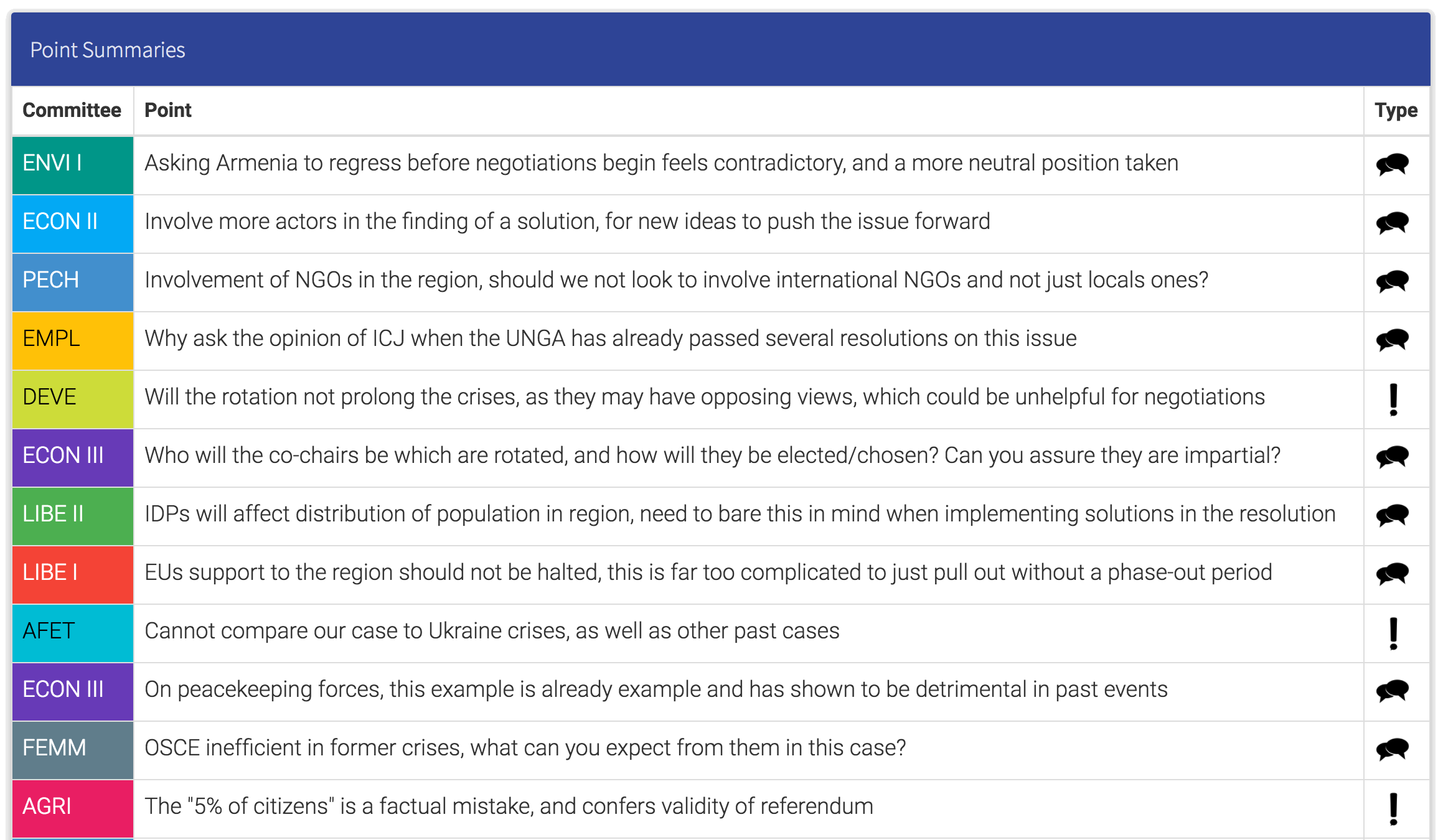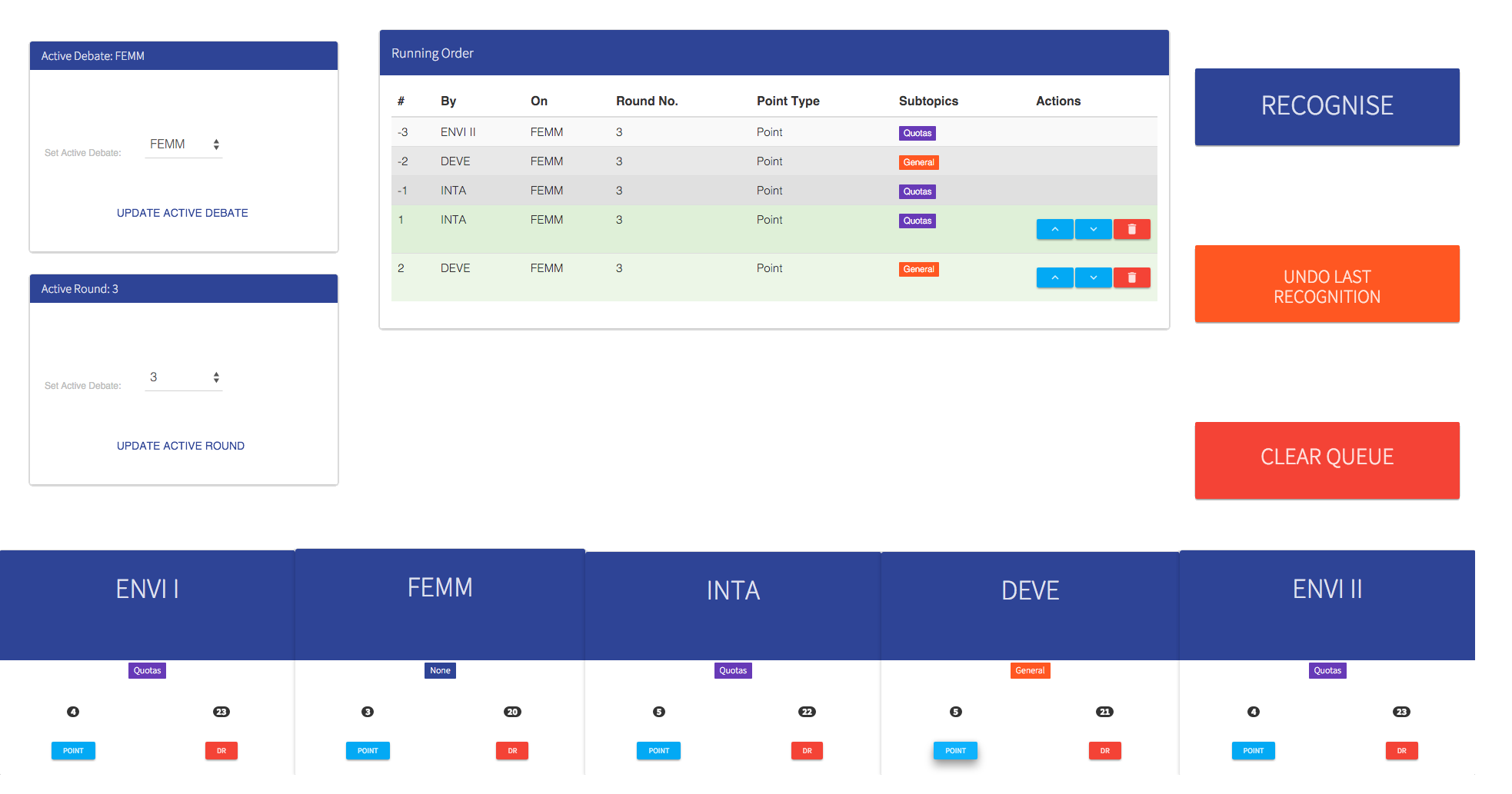Which modules does GA Statistics offer?¶
GA Statistics is composed of five main modules. Statistics, Point Content, Voting and Gender Statistics. There is also a module which activates a smarter GA, called Running Order
Statistics¶

The Statistics module as found on the debate page.
Usually in the statistics module, chairs will submit a point every time their committee speaks in open debate, stating the subtopic of the point - what it was about. As the points accumulate, GA Statistics provides some really cool insight into what is really happening in GA. Are the points evenly distributed among the committees? Which committee had the most direct responses? Which subtopics have been addressed? All this data is shown live in front of the audience, ideally projected behind where the board is sitting.
TLDR; Pretty Graphs
Point Content¶

The Point Content module as found on the debate page
As opposed to statistics only stating which topics have addressed during the GA, point content states what was actually said in each point. Imagine it like a tweet for each point, shortly describing what the point was about. This provides a timeline of what has happened during the debates and is very helpful in understanding what has already been said in a debate. You should consider whether you are going to need a dedicated group of individuals like Journalists or Organisers to manage these point summaries, as it is a demanding job and can be difficult for beginner Chairs to do while managing their committees during GA. When the committees are being chaired by two chairs, even beginner Chairs should not have any problems with summarising the points. Advanced Chairs can also submit the summaries when they are chairing alone. We recommend that chairs let their Delegates write down summaries of their own points on Post-It’s before they even make the point. This will help the Chair who can use the Delegate’s summary as a guideline and even the Delegate who actually needs to think about what to say before they have the floor. Trust us, it is worth the effort.
TLDR; Short summaries of each point
Voting¶

The Voting module as found on the debate page
The voting module does exactly what it says on the tin - it allows digital voting. Digital voting is good for a few reasons, the maths is never wrong, voting is more transparent since you can see how each committee has voted, and - our personal favourite - if it is a close vote, there is an incredibly tense atmosphere as everyone watches the votes come in. Again, the chairs submit this data from their phones.
TLDR; Digital Voting
Gender Statistics¶
Note
These statistics are not publicly visible. While you are free to show them, they will stay internal by default.
Gender statistics allow you to track the gender equality of your General Assembly. A single person tracks gender statistics during GA, and the results are shown only to the session admin. Gender statistics are not only useful for you to keep track of the equality of your GA, but it also helps the organisation as a whole, as it allows the International Office to view and analyse gender statistics for the whole EYP.
TLDR; Tracking Gender Equality
Running Order Mode¶
Different to the normal mode of GA Statistics, where chairs notify GA Statistics once they have made a point, telling the platform which subtopics the point was on and what the point was about, Running Order Statistics gets chairs to tell the board what their next point will be about in advance. The board uses this information to decide the running order of the GA. Perhaps three points should be taken regarding asylum seekers before returning to the proposing committee? The running order is publicly displayed on the committee page, notifying the GA which committees will be speaking next. Once the board recognises a committee, the point is saved using the subtopic the chair predicted.

The interface the board of the session uses to manage GA when the Running Order module is enabled.
All Direct Responses are automatically placed first in the queue, and the subtopic is automatically assigned to that of the last recognised point. If a chair at any point in time predicts the wrong subtopic - or the delegate changes his mind and speaks about something different, each chair can edit the subtopics of all points they submitted on the same page they use to predict the next subtopic.
Note
We think that running order statistics are the most efficient use of GA statistics as it can significantly increase the quality of GA, however, at the time of writing — Running Order Statistics are fairly new and as such have not been tested as much as the other statistics types — there may be small bugs particularly concerning the running order page itself. These are usually fixed by refreshing the browser window, but errors can come up. Please report bugs if you should find any!
What should I pick?¶
You can combine all of the modules together in a way that suits the needs of your session. You need to pick at least the Statistics or Point Content module — the voting and gender statistics are optional but recommended!